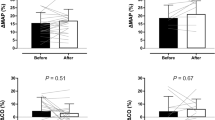Abstract
Hemodynamic responses to combined heavy dynamic leg exercise (hiP), breath holding (BH) and gravity-induced blood volume shifts direction were studied. Thirteen subjects were studied at normal gravity and 12 during parabolic flight, performing 20 s hiP or combined hiP&BH (stimulus period) from a baseline of 30 W at normal gravity (1 Gz+). Heart rate and mean arterial pressure responses to BH were similar between gravity conditions, but stroke volume (SV) differed markedly between gravity conditions: at 1 Gz+ SV was higher [112 ± 16 ml (mean ± SD)] during BH, than during eupnea [101 ± 17 ml (P < 0.05, N = 13)]. In weightlessness the corresponding SV values were 105 ± 16 and 127 ± 20 ml, respectively (P < 0.05, N = 6). Transthoracic electrical conductance (TTC) was used as index for intrathoracic volume. TTC fell significantly during BH. This decrease was attenuated in weightlessness. It is concluded that the transient microgravity temporarily reduces the efficiency of the muscle pump so that the deep inspiration at the onset of the high-intensity exercise and breath-hold period cannot augment venous return as it could during identical manoeuvres at normal gravity.






Similar content being viewed by others
Abbreviations
- BH:
-
Breath-hold
- CBP:
-
Continuous arterial blood pressure
- CBPD:
-
Continuous arterial blood pressure device
- CO:
-
Cardiac output
- dCO:
-
Delta cardiac output
- dHR:
-
Delta heart rate
- dMAP:
-
Delta mean arterial pressure
- dSV:
-
Delta stroke volume
- dTPR:
-
Delta total peripheral resistance
- dTTC:
-
Delta transthoracic electrical conductance
- ECG:
-
Electrocardiogram
- Gz+ :
-
Gravity in the head-to-foot direction
- hiP:
-
High power
- HR:
-
Heart rate
- loP:
-
Low power
- MAP:
-
Mean arterial blood pressure
- PF:
-
Parabolic flights
- SV:
-
Stroke volume
- TPR:
-
Total peripheral resistance
- TTC:
-
Transthoracic electrical conductance
References
Cerretelli P, Sikand R, Farhi LE (1966) Readjustments in cardiac output and gas exchange during onset of exercise and recovery. J Appl Physiol 21:1345–1350
Deakin CD, McLearn RM, Peley GW, Clewlow F, Dalrymple-Hay MJR (1998) Effects of positive and end-expiratory pressure on transthoracic impedance—implications for defribillation. Elsevier Sci 37:9–12
Drummond GB, Nimmo AF, Elton RA (1996) Thoracic impedance used for measuring chest wall movement in postoperative patients. Br J Anaesth 77:327–332
Folkow B, Haglund U, Jodal M, Lundgren O (1971) Blood flow in the calf muscle of man during heavy rhythmic exercise. Acta Physiol Scand 81:157–163. doi:10.1111/j.1748-1716.1971.tb04887.x
Hoffmann U, Smerecnik M, Leyk D, Essfeld D (2005) Cardiovascular responses to apnea during dynamic exercise. Int J Sports Med 26:426–431. doi:10.1055/s-2004-821113
Johns JP, Vernalis MN, Karemaker JM, Latham RD (1994) Doppler evaluation of cardiac filling and ejection properties in humans during parabolic flight. J Appl Physiol 76:2621–2626. doi:10.1063/1.357558
Karmali F, Shelhamer M (2008) The dynamics of parabolic flight: flight characteristics and passenger percepts. Acta Astronaut 63:594–602. doi:10.1016/j.actaastro.2008.04.009
Kubicek WG, Krnegis JN, Patterson RP, Witsoe DA, Mattson RH (1966) Development and evaluation of an impedance cardiac output system. Aerosp Med 37:1208–1212
Lin YC (1982) Breath-hold diving in terrestrial mammals. Exerc Sport Sci Rev 10:270–307. doi:10.1249/00003677-198201000-00009
Lindholm P, Linnarsson D (2002) Pulmonary gas exchange during apnoea in exercising men. Eur J Appl Physiol 86:487–491. doi:10.1007/s00421-002-0581-9
Lindholm P, Sundblad P, Linnarsson D (1999) Oxygen-conserving effects of apnea in exercising men. J Appl Physiol 87:2122–2127
Lindholm P, Nordh J, Linnarsson D (2002) Role of hypoxemia for the cardiovascular responses to apnea during exercise. Am J Physiol Regul Integr Comp Physiol 283:R1227–R1235
Linnarsson D (1974) Dynamics of pulmonary gas exchange and heart rate changes at start and end of exercise. Acta Phys Scand [Suppl] 415:1–68
Linnarsson D, Sundberg CJ, Tedner B, Haruna Y, Karemaker JM, Antonutto G, Di Prampero PE (1996) Blood pressure and heart rate responses to sudden changes of gravity during exercise. Am J Physiol 270:H2132–H2142
Miyamoto Y (1992) Kinetics of respiratory and circulatory responses to step, impulse, sinusoidal and ramp forcings of exercise load in humans. Front Med Biol Eng 4:3–18
Petersen JR, Jensen BV, Drabaek H, Viskum K, Mehlsen J (1994) Electrical impedance measured changes in thoracic fluid content during thoracentesis. Clin Physiol 14:459–466. doi:10.1111/j.1475-097X.1994.tb00404.x
Raynaud J, Bernal H, Bourdarias JP, David P, Durand J (1973) Oxygen delivery and oxygen return to the lungs at onset of exercise in man. J Appl Physiol 35:259–262
Rowell LB, O’Leary DS (1990) Reflex control of the circulation during exercise: chemoreflexes and mechanoreflexes. J Appl Physiol 69:407–418
Acknowledgments
This study was funded by the DLR (Deutsches Zentrum für Luft und Raumfahrt), Germany (FKZ: 50WB0426). We thank the European Space Agency for the opportunity for experiments in parabolic flights and DAMEC (Denmark) and CNSystem (Austria) for technical support.
Author information
Authors and Affiliations
Corresponding author
Rights and permissions
About this article
Cite this article
Hoffmann, U., Dräger, T., Steegmanns, A. et al. Influence of combined exercise and gravity transients and apnea on hemodynamics. Eur J Appl Physiol 106, 589–597 (2009). https://doi.org/10.1007/s00421-009-1052-3
Accepted:
Published:
Issue Date:
DOI: https://doi.org/10.1007/s00421-009-1052-3




